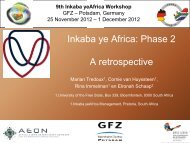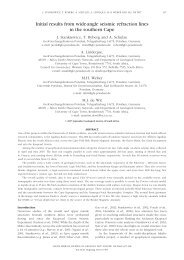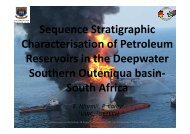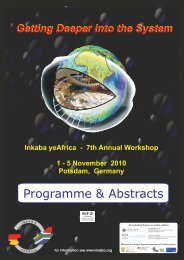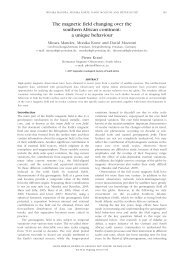South Africa - Inkaba.org
South Africa - Inkaba.org
South Africa - Inkaba.org
You also want an ePaper? Increase the reach of your titles
YUMPU automatically turns print PDFs into web optimized ePapers that Google loves.
Study of the geo-electrical anisotropy in the Cape Fold Belt<br />
using magnetotelluric<br />
X. Chen 1, 2 , U. Weckmann 1<br />
1. Helmholtz Centre Potsdam – German Research Centre for Geosciences, Potsdam, Germany<br />
2. Institute of Earth and Environmental Sciences, University of Potsdam, Potsdam, Germany<br />
xiaoming@gfz-potsdam.de , uweck@gfz-potsdam.de<br />
ABSTRACT<br />
Within the framework of the German - <strong>South</strong> <strong>Africa</strong>n geo-scientific research initiative <strong>Inkaba</strong> ye<strong>Africa</strong> a series of<br />
magnetotelluric (MT) field experiments were conducted along the Agulhas-Karoo Transect in <strong>South</strong> <strong>Africa</strong>. This<br />
transect crosses several continental collision zones between the Cape Fold Belt, the Namaqua Natal Mobile Belt<br />
and the Kaapvaal Craton. Along the Cape Fold Belt profile we can identify areas (> 10km) where MT sites exhibit<br />
phases over 90 degrees. This phenomenon usually occurs in presence of electrical anisotropy. Due to the dense site<br />
spacing we are able to observe this behaviour consistently at several sites.<br />
With isotropic 2D inversion we are able to explain most features in the MT data but not the abnormal phase<br />
behaviour. In order to explain the abnormal phase behaviour we have to include zones of electrical anisotropy.<br />
Currently, we can use 2D anisotropic forward modelling to reproduce the general trend of phases leaving the<br />
quadrant. To explain the MT data in more detail, 2D anisotropic inversion would be desirable. In this presentation<br />
we focus on a spatially constraint 2D anisotropic inversion. In a first step, we use simple 2D models with<br />
embedded zones of electrical anisotropy to study the general influence of anisotropy parameters. In a second step,<br />
isotropic 2D inversion results are used as background models in which we include anisotropic zones in order to fit<br />
the abnormal phase curves in the data. For these forward modelling studies we implemented the 2D anisotropic<br />
code by Pek & Verner (1997) into the modular EM modelling and inversion software (Egbert, 2006; Egbert &<br />
Siripunvaraporn, 2008). The modular system provides an ideal environment to implement this inversion scheme.<br />
KEYWORDS: Cape Fold Belt, magnetotelluric, anisotropy, modelling, constraint inversion.<br />
14




